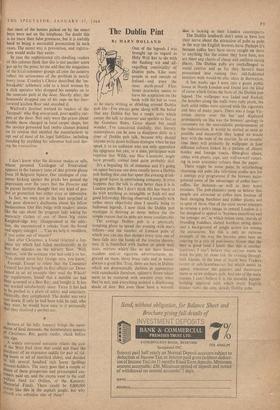The Dublin Pint
By MARY HOLLAND
ONE of the legends I was brought up to regard as Holy Writ has to do with the flashing wit and all- engulfing conviviality of Dublin pubs. Like most people in and outside of Ireland—and even the most myth-proof Fleet Street journalist seems to leave his scepticism on the hook with his hat as soon as he starts writing or drinking around Dublin pub life—I've always gone along with the belief that any Dublin bar has a magic aura which causes the talk to shimmer and sparkle as fast as the Guinness flows. Great shame but small wonder, I've concurred dutifully, that literary masterpieces can be seen to disappear daily in a river of Dublin pub talk, because why should anyone write down brilliant dialogue when he can speak it to an audience who not only appreciate his epigrams but can, to a man, participate with repartee that Wilde, nay Mac Liammair, might have proudly coined (and quite probably did).
It's a beguiling bit of nonsense and it's going on apace because one does usually leave a Dublin pub feeling that one has spent the evening drink- ing good liquor in entertaining company. It even happens that the talk is often better than it is in London pubs. But I don't think this has much to do with anything as intangible as Irish wit and good fellowship. Having observed it recently with rather more objectivity than I usually bring to hallowed legends, I now think the Dublin pub mystique is thriving as never before for the simple reason that its pubs are 'more comfortable.
The average Dublin pub is a physically tempting place to spend the evening with one's fellows—and the number of London pubs of which you can say that shrinks every time one of them falls into the hands of the interior decora- tors. It is furnished with leather or plush wall seats, mirrors which like as not have lissom maidens and/or cigarette advertisements en- graved on them, 'shiny brass rails and in winter always a good fire. True, there are bars in Dublin which are determinedly shebeen in appearance with ramshackle furniture, splintery floors which seem to be scattered with sawdust even when they're not, and everything painted a displeasing shade of dun. But even these have a warmth that is lacking in their London counterparts.
The Dublin landlords don't seem to have lost their nerve about the attraction of pubs as pubs in the way the English brewers have. Perhaps it's because coffee bars have never caught on there to anything like the extent they have here, nor are there any chains of cheap and uniform eating Places. The Dublin pubs are unchallenged as social centres and so far they haven't been pressurised into ruining their old-fashioned interiors with would-be chic ideas in decoration.
A few weeks ago 1 went into a gaunt public house in North London and found just the kind of room which forms the basis of the Dublin pub legend. The wallpaper was faded and flocked, the benches along the walls were ruby plush, the dark solid tables were scarred with the cigarettes and beer of many years. There was a large Vic- torian mirror over the bar and displayed prominently on this was the brewers' apology to customers for the unavoidable postponement of the redecoration. It would be started as soon as possible and meanwhile they hoped we would bear with the state of the interior. In six months' time there will probably be wallpaper in four different colours linked by a pattern of chianti bottles and foreign toasts, fibre-glass chairs, tables with plastic tops, and wall-to-wall carpet- ing in even screamier colours than the paper.
There might be some point in refurbishing charming old pubs like television studio sets for a teenage pop programme if the brewers incor- porated some of the advantages of coffee bars— coffee, for instance—as well as their worst excesses. The pub-planners seem to believe that people are attracted to coffee bars because of their swinging bamboos and rubber plants; not in spite of them. One of the most recent attempts to revamp a pub's image in central London is a bar designed to appeal to 'business executives and the younger set,' in which rattan cane, murals of brooding buddhas, slatted bamboo swing doors and a background of jungle noises are among the attractions. Yet this is only an extreme example of the way the brewers seem bent on catering to a city of pub-lovers. Given that the beer is good (and I know that this is another question), I can't believe that anyone wants to drink his pint, let alone talk the evening through with friends, in the kind of South Seas Traders tavern or sub-Scandinavian bar which seems to appear whenever the painters and decorators move in on an ordinary pub. And one of the main reasons 1 can't believe it is the maudlin legend- building approval with which every English drinker views the cosy, dowdy Dublin pubs,


































 Previous page
Previous page